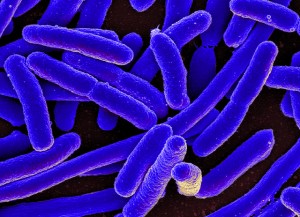Our intestines have a complex army of immune cells and molecules that work together fighting against bacterial infections. A new hypothesis suggests that this army is not only made up by the body’s own defensive system, but that commensal bacteria are also recruited as allies against intruders. Some questions raised by this hypothesis are how the immune system and commensal bacteria communicate and where recruitment takes place.
TUESDAY, 16 FEBRUARY 2016
 Commensal bacteria help protect us from pathogenic ones.
Commensal bacteria help protect us from pathogenic ones. Collaborative work published in Nature Immunology and led by Prof Gabrielle Belz from Melbourne and Prof Eric Vivier in Marseille provides insights into to these questions. The researchers were interested in immune cells called innate lymphoid cells (ILCs), particularly those expressing the protein Natural Cytoxicity Receptor (hereafter described as NCR+ ILCs). The NCR+ ILC subset and another type of immune cells called T lymphocytes had been previously described to be important in protecting mice from bacterial gut infection through production of an attractant for commensal bacteria. The cooperation between these different cell types is still poorly understood. The researchers used mice infected with pathogenic Citrobacter rodentium as a model for bacterial infection in human intestines. In a series of elegant experiments, the scientists not only demonstrated that T lymphocytes and NCR+ ILCs played redundant roles during intestinal infection, but also that NCR+ ILCs were able to compensate for a lack of T lymphocytes. Moreover, the scientist discovered that NCR+ ILCs could protect the cecum (which is the part of the intestine where bacterial infections start) from inflammation and injury during bacterial infection. The researchers suggest that NCR+ ILCs might protect the cecum from damage through their ability to recruit commensal bacteria, possibly from the appendix.
The team behind the discoveries are very positive about the findings. Prof Gabrielle says in a press release: “We’ve found that ILCs may help the appendix to potentially reseed ‘good’ bacteria within the microbiome — or community of bacteria — in the body.” The discovery could lead to new therapeutic approaches for treating intestinal infections.
DOI: 10.1038/ni.3332
Image by NIAID
Written by Anaid Diaz
 Commensal bacteria help protect us from pathogenic ones.
Commensal bacteria help protect us from pathogenic ones.